The strategic analysis, also known as the strategic diagnosis, is the first step in every company’s planning process.
After having the results of your strategic analysis, you will be in a better position to clarify your company’s goals and make the best strategic choices.
To conduct the strategic analysis, managers and management authors use a variety of analysis tools, which are frequently classified into two big categories:
Tools for external strategic analysis include the PESTEL analysis, which examines the company’s macroenvironment, and Michael Porter’s five competitive forces model, which analyzes the company’s microenvironment.
Internal strategic analysis tools include:
- The Benchmark.
- Jay Barney’s VRIO analysis model.
- Michael Porter’s value chain model.
The SWOT analysis is a strategic planning tool that helps you summarize the main results of your strategic analysis.
The results of internal and external strategic analysis are contrasted using the SWOT framework to determine the best strategic options for your company.
In this illustration, we’ll review the main insights of Aldi’s internal and external strategic diagnosis. Here is the SWOT analysis of Aldi.
Aldi overview
ALDI, which stands for ALbrecht-DIscount, is a global retail company originally based in Germany. The group is a family business founded in 1913 in a popular district in Essen by the mother of Theo and Karl Albrecht.
After the Second World War, the two sons took over the family store and gradually developed it into an international retail company. Aldi is, above all, a family business that has belonged to Anna Albrecht since 1916. The Albrecht Sons decided to apply discounts on sales prices in 1946.
Due to disagreements, the company is split in two: Aldi North for Theo Albrecht and Aldi South for Karl Albrecht. The international development will keep this modification and will be managed on the same north/south mode.
The Aldi brand was created in 1962 as a contraction of Albrecht-Discount.
Today, the company has more than 11,000 stores in 20 countries, generating a total revenue of 29.3 billion euros. Its mission statement is: “Higher quality, lower prices”.
The mother of the two businessmen has become famous for saying, “The worse the world gets, the better off we are.”
The two brothers divided the world’s regions as the group expanded internationally.
Theo via Aldi-Nord manages the Belgian, Danish, Spanish, French, Luxembourg, Dutch, and Polish subsidiaries, while Karl via Aldi-Süd is responsible for Austria, Switzerland, and the Anglo-Saxon world (Australia, USA, Ireland, UK).
This German giant, present today in several developed and emerging countries, is constantly expanding its activities and innovating its products and services by making the most of the opportunities in its environment.
However, Aldi is facing more serious economic and sociocultural threats and risks, particularly the complexity of international markets and the emergence of new competitors.
To perform a company’s strategic analysis and make good strategic choices, strategy experts usually use the SWOT model to identify and measure the company’s strengths and weaknesses as well as the current and potential opportunities and threats in its environment.
This article will present our Aldi SWOT analysis example based on our team’s latest research and analysis.

The internal strategic factors of Aldi
Internal strategic analysis is used to identify your company’s strengths and weaknesses. Strengths are the competitive advantages, capabilities, expertise, experience, skills, and other internal factors that cannot be easily imitated.
They allow your company to position itself better in the market than competitors. For Aldi, we have identified the following strengths from our literature review.
Strengths of Aldi
1. Low prices
All hard discounters, such as Aldi, ensure their sustainability and growth through the low prices they offer their customers.
All the products that consumers use daily are sold at relatively low prices compared to other retail giants (Target, Walmart).
Thus, low prices are a very important strength of the Aldi brand.
2. High customer satisfaction
Aldi stores offer many well-assorted products with low prices compared to the competition. Middle and low-income customers express high satisfaction with the Aldi brand.
Indeed, the low prices of Aldi stores allow customers to make significant savings on their food purchases.
In addition, the arrival of the Covid-19 crisis and the current global economic recession have enabled Aldi to attract even customers from other retailers with higher prices than Aldi.
3. Effective customer service
The discount stores have a strong environment supporting most food retail parameters.
In addition to low prices, Aldi also has other factors such as multiple store locations, shopping convenience, merchandise assortment, store atmosphere, visual merchandising, and low customer waiting time.
4. Good Brand awareness and reputation
Aldi has been recognized as an excellent brand, is the fifth largest retailer in the UK, and has about 8% of the market share.
The brand has received strong popularity over the years. The value of the brand and the place it holds with the customers make it a great asset.
5. Reliable distribution network
Having been in the market for many decades, Aldi has developed strong and reliable relationships with all its stakeholders. It maintains a strong supplier base and ensures no disruptions to customer expectations.
Through its efficient and reliable distribution network, Aldi ensures that its products reach the target market in the right quantities and at the right time.
6. Customer portfolio
Aldi has built a huge base of loyal customers over the years. Its unbeatable prices have driven customers to visit its stores worldwide.
In addition, due to its excellent customer service and wide range of products, Aldi has many loyal customers to its brand. Many customers always buy from this brand without looking to other retailers.
Weaknesses of Aldi
It is evident that Aldi has been expanding rapidly and has become one of the largest retail chains in the world. However, like any other business, Aldi has its weaknesses.
One of the most significant challenges that the company faces is its distribution chain. Weaknesses are the factors that limit your company’s ability to achieve its goals. For Aldi, we have identified the following weaknesses.
1. Limited Product Range
One of the weaknesses of the Aldi distribution chain is its limited product range. Aldi typically stocks only around 1,500 products, significantly less than its competitors.
This limited range means that Aldi may only be able to meet the needs of some customers. Some customers may have to go to other retailers to find specific products that Aldi does not stock.
2. Overreliance on Private Label Products
Aldi strongly focuses on private-label products, a strategy that has worked well for the company. However, over-reliance on personal label products can also be a weakness. Private label products may not be as well-known or trusted as branded products, which may deter some customers from shopping at Aldi.
3. Inefficient Supply Chain
Aldi’s supply chain could be more efficient. The company sources its products from a limited number of suppliers, which can result in supply chain disruptions if one of the suppliers experiences an issue.
Additionally, Aldi’s distribution centers may need to be optimally located, leading to longer lead times and higher transportation costs.
4. Limited Store Layout
Aldi stores typically have a limited layout, focusing on simplicity and efficiency. However, this can also be a weakness, as it may make it difficult for customers to find what they are looking for. Additionally, the limited store layout may deter some customers who prefer a more spacious and open shopping environment.
5. Limited Online Presence
Aldi needs a more online presence, which can be a weakness in today’s digital age. Online shopping is becoming increasingly popular, and Aldi’s limited online presence may dissatisfy some customers who prefer to shop online.
Furthermore, Aldi’s online platform may need to be more user-friendly and convenient than its competitors, which can also be a weakness.
6. Limited Advertising
Aldi has a limited advertising budget compared to its competitors, which can be a weakness. Advertising is essential for retailers to reach new customers and retain existing ones.
The limited advertising budget of Aldi may mean the company could get more potential customers.
7. Low-profit margins
Aldi stores offer very low prices to consumers. As a result, this sales strategy harms the company’s margins.
Therefore, the profits of Aldi depend largely on the volume of sales. Most of the time, company managers carry out many unethical practices, such as price discrimination.
In this way, the company tends to mistreat its suppliers to guarantee a constant margin.
8. Employee dissatisfaction
Aldi constantly makes huge efforts to satisfy its customers, but its employees are dissatisfied. To be competitive in the market, Aldi has to increase its productivity at the expense of its employees’ well-being.
Most of its employees have to work long hours and multitask. Aldi’s employees are paid less than the market standard.
As a result, most of Aldi’s employees are dissatisfied with the working conditions, and the attrition rate is higher, negatively influencing the company’s reputation in the labor market.
The external strategic factors of Aldi
The second part of the strategic analysis of companies is to elaborate on the external analysis. The external diagnosis aims to estimate the opportunities and threats of your company’s environment.
To carry out this analysis, strategic management specialists distinguish between the macro-environment and the company’s micro-environment.
Opportunities of Aldi
Opportunities are favorable external factors that allow your business to grow and be more profitable. Here are the main opportunities in the global hard discount market:
1. Huge growth potential in emerging countries
The purchasing power of consumers in emerging markets such as Brazil, Turkey, and India is constantly increasing, which has a positive impact on the demand for food and other products sold by Aldi;
2. Good reputation of German brands
Over the years, “Made in Germany” has become a quality label perceived by international consumers as an indication of high-quality products.
Several market studies and surveys have shown that German products enjoy an excellent reputation worldwide. German brands are often known for their durability and prestige.
This strong brand image in the minds of the global consumer represents a significant opportunity for German companies to enter foreign markets.
3. Global demand for food products
United Nations estimates that the world’s population will reach eight billion on Tuesday, November 15, 2022. Moreover, the growth of the world population is expected to continue over the years.
Thus, the demand for different food products is constantly increasing.
Food purchases are part of the category of necessities. These facts will allow hard discounters like Aldi to maintain their expansion and ensure their sustainability in the long term.
4. The benefits of globalization
The positive effects of globalization have led to the standardization of consumer habits and lifestyles of the global consumer.
Everyone wants to shop in large and medium-sized stores that are attractive and have a good atmosphere for consumers to have a pleasant shopping experience.
5. Free trade agreements
In recent years, the German government has signed several free trade agreements with many countries that represent promising business opportunities for German companies.
These agreements allow German multinational companies, such as Aldi, to easily penetrate high-potential markets by establishing subsidiaries and franchises and generating considerable revenues and profits.
Threats of Aldi
Threats are external risks and barriers your company must overcome to ensure its growth and sustainability. In this section, we are going to share with you the major threats related to the hard discount market on a global scale:
1. Strong competition in the European and American markets
Becoming one of the world’s leading hard discounters is difficult, but staying on top for a long time is even more difficult.
Today, more than ever, Aldi is facing fierce competition from the big retail giants (Walmart, Tesco, Costco, Lidl) in the European Union, the United Kingdom, and the United States markets.
There is also the serious threat of the continuous arrival of new competitors who are well-armed and have considerable financial and commercial capacities.
These markets have become very saturated, and their penetration is becoming increasingly difficult for a brand like Aldi.
2. Economic, political and social risks
At the cultural level, it is clear that consumer behavior and buying habits are constantly changing. Global consumers seek products and services with high-added value and reasonable prices.
The ultra-connected Generation Z is ready to test and adopt new, more comfortable shopping methods such as drive-through and online shopping and is constantly looking for personalized and enjoyable shopping experiences.
Politically, the United Kingdom and the United States are Aldi’s main markets. Much of the company’s sales will be at risk if trade and political tensions between the European Union and these two giants escalate.
Thus, Aldi’s business performance largely depends on global economic and political stability.
Finally, as the Aldi Group operates globally, it is always affected by exchange rate fluctuations. The company reports its financial earnings in euros, which affects its revenues and profits because the European currency is constantly exposed to volatility compared to other currencies, such as the American dollar or the British pound.
3. Global economic recession
Covid-19 is gone, but those negative impacts are still there. An unprecedented economic recession now marks the global economic environment.
The deterioration in purchasing power has caused the global consumer to avoid, as much as possible, impulse or unnecessary purchases (gifts, gadgets, accessory products).
4. Strict regulations and laws
Aldi is present in several countries on different continents. As a result, the company’s managers must consider the sometimes contradictory laws and regulations of each country in which Aldi operates.
Moreover, these laws are constantly changing. Neglecting or not strictly complying with the laws of each country can cause dramatic economic and financial damage to the Aldi brand.
5. Negative effects of the war in Ukraine
A survey of some 500 companies conducted by the German Federal Bank has revealed that production losses due to the war in Ukraine will increase in the second quarter of 2022.
Some German manufacturers fear considerable production losses” until 2024. Because of its heavy dependence on Russian gas and the weight of its industry, Germany is more exposed than its European neighbors to the economic consequences of the war in Ukraine.
SWOT analysis matrix of Aldi 2024
To summarize Aldi’s SWOT analysis, we propose a summary of Aldi’s strengths, weaknesses, opportunities, and threats in the form of a SWOT matrix.
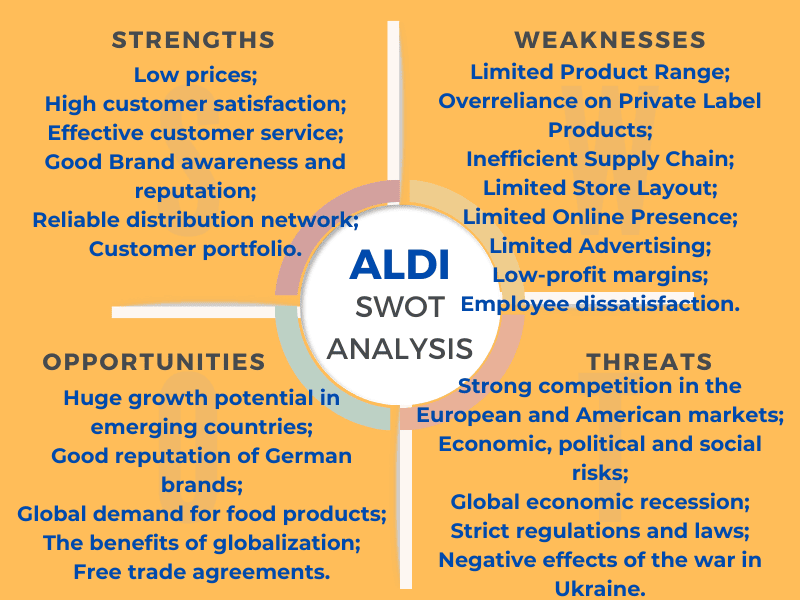
Final thoughts
By 2024, Aldi will be one of the leading hard discount retailers worldwide. The group continues to expand into new high-potential markets, such as the USA and Australia.
The company’s key indicators are all in the green and are steadily improving. However, the harmful effects of the current global economic recession and competitive pressure are the main threats that Aldi’s management must consider to maintain its position and ensure its international expansion.
There is no better way to understand how to conduct a SWOT analysis at your company level than with a concrete example.
Below you will find our free, up-to-date, and concrete examples of SWOT analyses of large companies and multinationals conducted in 2024.
Competitor SWOT analysis
Click here to read the full article on the competitor SWOT analysis!
Click here to check our New example of SWOT analysis for parks and recreation in 2022!
Click here to check our New example of AMC Entertainment SWOT analysis!

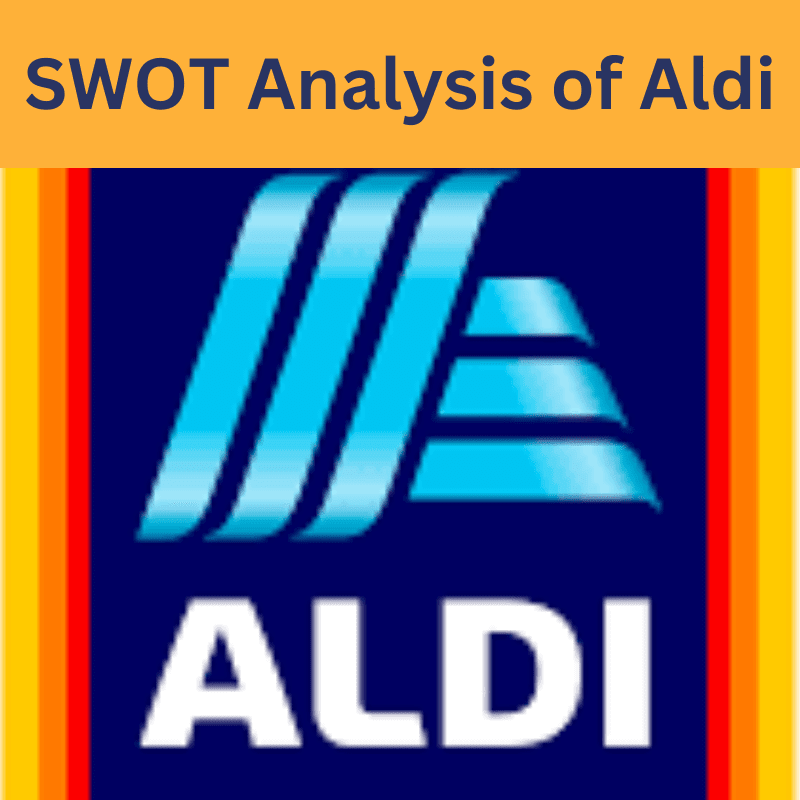



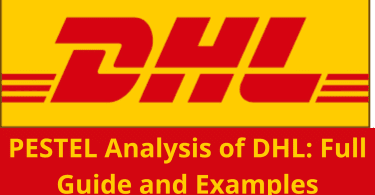
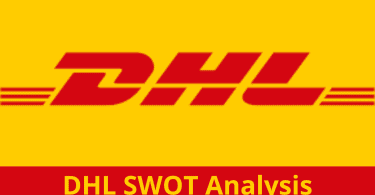

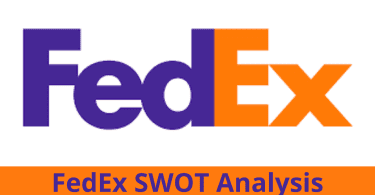
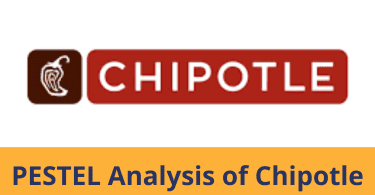





Leave a Comment